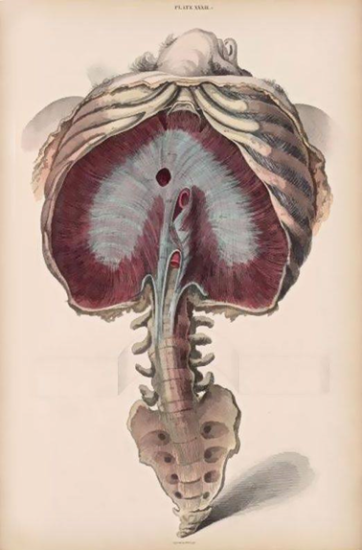The diaphragm is the main respiratory muscle that performs the most important work.
 It is a muscular separation between the abdominal cavity and the chest cavity. In abdominal breathing, the abdomen expands outward as you inhale and the diaphragm moves inward. These two activities cause a drop in the internal pressure that pulls air into your lungs. As you exhale, your abdominal muscles contract and pull in slightly, and the diaphragm rises and pushes air out of your lungs. This gives you deep and regular breathing that allows your lungs to be almost fully ventilated. Thoracic breathing, involving only the upper thorax and the intercostal muscles, is generally shallow, rapid, and irregular with minimal air exchange.
It is a muscular separation between the abdominal cavity and the chest cavity. In abdominal breathing, the abdomen expands outward as you inhale and the diaphragm moves inward. These two activities cause a drop in the internal pressure that pulls air into your lungs. As you exhale, your abdominal muscles contract and pull in slightly, and the diaphragm rises and pushes air out of your lungs. This gives you deep and regular breathing that allows your lungs to be almost fully ventilated. Thoracic breathing, involving only the upper thorax and the intercostal muscles, is generally shallow, rapid, and irregular with minimal air exchange.
 The quality of our breathing is the basis of our mental condition. Diaphragm blockade is a form of our character armor, reflecting the ego’s inability to integrate the feelings concentrated in the chest cavity and express them through the solar plexus, pelvis, and thighs. The tension in the diaphragm embodies the reluctance to experience or articulate emotions, and the resistance to mobilizing a force in the solar plexus to act according to them. In this way, the inflow of energy to the solar plexus is blocked, suppressing vitality and a sense of fulfillment. We tighten the diaphragm because we are afraid to breathe fully, we are afraid to truly experience and feel.
The quality of our breathing is the basis of our mental condition. Diaphragm blockade is a form of our character armor, reflecting the ego’s inability to integrate the feelings concentrated in the chest cavity and express them through the solar plexus, pelvis, and thighs. The tension in the diaphragm embodies the reluctance to experience or articulate emotions, and the resistance to mobilizing a force in the solar plexus to act according to them. In this way, the inflow of energy to the solar plexus is blocked, suppressing vitality and a sense of fulfillment. We tighten the diaphragm because we are afraid to breathe fully, we are afraid to truly experience and feel.
The way we breathe is closely related to the bodily chemistry of emotions. On a psychological level, diaphragmatic breathing increases emotional stability, confidence, awareness, and perceived control of the environment, while thoracic breathing does the opposite. Diaphragmatic breathing reduces anxiety, depression and psychosomatic problems.
How to activate the diaphragm?
Lie on your back in a quiet place with your knees bent and your feet flat on the floor. Use your fingers to feel the lower edge of the chest starting at the top, about 10-15 cm from the breastbone, and massage from the top to the bottom on both sides of the breastbone. Run your fingers along the edge of your chest, not under it.
Focus more and breathe to areas where the tissue seems to be sticky or feels lumpy or painful. It can be uncomfortable and even painful, gently massage these areas, don’t force them. Continue for a few minutes. Regularly relax your diaphragm.
Breathe your belly!
When the diaphragm is more relaxed, start using it.
Place your hand gently on your belly below the navel and direct your breath and attention there. Close your eyes so that you can fully concentrate on your breathing. Inhale air through your nose and exhale through your mouth. Breathe into your stomach until it rises, then let out all the air. Breathe slowly. Try to avoid the movement in the upper chest and neck (this is where we tend to breathing shallowly). Continue for two minutes.
At the beginning, practice lying down, increasing to 10 minutes a day. Once you are able to belly breathe in the supine position, try the same in a sitting position, and then move on to standing, walking and exercising. Incorporate belly breathing into your daily activities. Breathe your belly at the desk, in the bathtub, watching TV, walking the dog, and especially breathe your belly, you will feel nervous, stress, tension.
And if you feel that you need support in this practice and work on your diaphragm, I invite you to the sessions. If you have a question, please do not hesitate to contact me: kontakt@exploreself.pl
Agnieszka
Source: „Energetic anatomy. Body as Consciousness”, Bruce Burger.
Main photo: Michael Baussman, Pixbay
